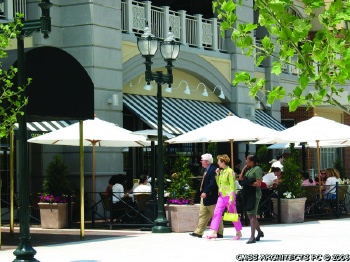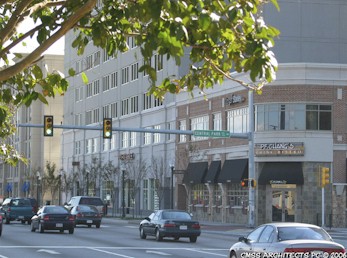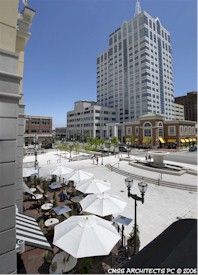|
Andres
Duany, the New Urbanism evangelist, carries a
carousel of slides to illustrate his speeches with
real-world examples of atrocious urban design. For
years, one of his favorites -- for all I know, he
uses it still -- was an aerial shot of the
intersection of Independence and Virginia Beach
Boulevards in the Pembroke area of Virginia Beach.
This
suburban abomination consisted of 20 or more lanes
of traffic colliding at a single point. Flanking the
thoroughfares were acres upon acres of mostly empty
parking lot. And shoved off to the edges of the
image -- separated by vast distances that no sane
person would negotiate on foot -- were isolated
stores and office buildings. Clearly, Duany would dead-pan with his
inimitable sarcasm, Virginia Beach had designed the
community for the care and feeding of
automobiles. People evidently did not figure into
the equation.
It
may be time for Duany to find a new slide.
Pembroke,
the
least likely of locations, is undergoing a thorough-going transformation. Several blocks are blossoming with high-rise towers,
parking decks, condominiums, stores, offices and
restaurants. The streets are bustling with business executives, lunch goers,
errand runners, even joggers.

Foot
traffic through Fountain Square Plaza
What's
more, Burrell Saunders, the architect of that
transformation, predicts that it is a matter of only
a few years before the entire area, known as Town
Center, evolves into an urban hub second only to downtown
Norfolk in prominence in downtown Hampton Roads.
In
what had been an asphalt wasteland a few years ago, developers have brought online 300,000
square feet of office space, a comparable amount of
retail, 342 apartment units and a 176-room hotel. Under construction
today are another 42,000 square feet of retail, a 1,200-seat performing arts center
and a 37-story hotel/residential tower -- which will
be the tallest building in Virginia. All told: about
$400 million in investment.
The
project is moving faster than even he'd dreamed
possible, says Saunders, a principal in CMSS Architects and a proponent of the project since it
was first conceived some 20 years ago. Many people
mocked the idea of a "downtown" district
for Virginia Beach where nothing but malls and big
boxes had existed, but now that the projects are
taking shape, attitudes are changing.
Town Center
has become a destination. "The
community loves it," Saunders says. "People come here all
the time. For every one of the naysayers over the
years, there are dozens of people using it."
Town
Center clearly offers lessons for Virginia Beach, a
locality that is a "city" in name only.
With the second-largest population of any
jurisdiction in the Commonwealth, Virginia Beach
consists of a narrow urban enclave clinging to the
waterfront amidst an expanse of scattered,
disconnected, low-density sprawl. Seeing the success of Town Center,
Saunders says, city officials now are looking for
other locations where adding density can catalyze
similar re-development.
The
evolution of Pembroke into an urban center provides
an important lesson for other Virginia localities as
well: The most important thing that jurisdictions
can do is get out of the way.
In Saunders' view,
Virginia Beach's main contributions were twofold:
scrapping the zoning codes and other regulations
that locked development into expensive and
inefficient "sprawl" mode, and
creating a Tax Increment Financing District for the
development of structured parking and infrastructure
improvements. Once the city
let developers exercise their problem-solving
ingenuity, growth took off.
A
coalition of private business interests -- led by
Saunders, Gerald Divaris, Frederick Napolitano and
Richard Olivieri --
willed the urban center into existence in the face
of initial skepticism and apathy on the part of
city government. The city eventually
came on board with funds of its own: contributing to
parking, streetscapes, and other infrastructure
improvements with the increased tax revenue flowing
from the new development itself.
For
those who think that re-working failed suburbs is a
process that will take generations, Saunders'
assessment of Pembroke is profoundly optimistic.
Yes, developers and city officials should approach
their task with a 50-year planning horizon. "A
city," he says, "should be built to serve
generations." But Town Center has demonstrated
that it's possible to transform large pieces of the
physical environment in just a few years.
Furthermore,
insists Saunders, Virginia doesn't need to spend
mega-billions of dollars on new road and transit
projects to ameliorate traffic congestion.
"People say that density and congestion go
together. Why? On what basis? It's because they
think everyone has to get in their car at 5 p.m. and
drive home at the same time."
Town
Center has the densest concentration of development
in Virginia Beach, yet it's remarkably free of
congestion. That's because the only reason anyone
needs to drive a car is to get into Town Center or
leave it. Once you're there, you can conduct
business, shop, drink a beer, catch a laugh at the comedy club,
or even get your
car washed, all within easy walking distance. When
people do drive home, they don't all leave at the
exact same time.

Town
Center along Virginia Beach Boulevard
Transportation
is not an issue that should be left only to the traffic
engineers. Their solution is to add more lanes of
roadway. A better approach is to change where people
live, work and play. "We have enough roads,"
Saunders says. "We have enough asphalt. It's a
question of how you organize the use of the
asphalt."
Burrell
Saunders is one of the most important Virginians you
have never heard of. Tall,
silver-haired and courtly, he speaks with a soft
Virginia accent that betrays his boyhood origins in
Warrenton. Lacking the burning intensity
of celebrity architects like Duany, who write books and work the lecture
circuit, he exercises his
persuasive powers one-on-one and in small groups.
Saunders
loves the craft of urban design and would far rather
practice it than talk about it. Fortunately for him,
he's reached a station in life where he can choose
the projects he takes on. CMSS doesn't bid on RFPs, he says. He works with
developers who value his grasp of the big picture
and his understanding of how business, human and
architectural considerations interact. In
recognition of the value that it brings to the
table, CMSS is taking equity positions in many of
the projects it works on.
With
its headquarters across the street from Town Center,
CMSS maintains offices in Richmond and Reston, and
does business throughout the Mid-Atlantic. Saunders
co-owns his company with his partner John Crouse,
who also designs projects throughout the country and
the world such as the U.S. Embassies in Bulgaria and
Cote d'Ivoire. High-profile projects in the
Commonwealth include the East Beach project in
Norfolk's Ocean View neighborhood; the City Center at Oyster Point, in Newport
News; the Village at Rocketts Landing, in Richmond;
and the Old Town Village, in Fairfax.
In
many ways, Saunders sounds like a New Urbanist. His
principles of development revolve around creating a
"sense of place" -- building upon unique
historical or cultural themes that give a location a
sense of unique identity. He embraces many New
Urbanist fundamentals such as creation of public
spaces, careful integration of mixed uses,
establishment of an urban street grid and
painstaking attention to the pedestrian experience.
But where New Urbanism typically hearkens back to
the scale and density of small towns, and its
projects are usually planted fresh in green fields,
Saunders gets his thrills from the devilishly
complex task of re-working ill-functioning suburbs
into cityscapes. "My
job," he says, "is to take an area
developed in a suburban style and change it."
The challenge is to design cities fitted to the way
people want to live, not cities that conform to
antiquated zoning codes. As an example of how
regulations make cities unlivable, Saunders points to the rules
for parking lots. "The way land is developed
today, probably 90 percent of it is parking lot or
open space. We design parking lots for peak-time
use. There's a sea of parking around the office.
There's a sea of parking around the retail center.
There's a sea of parking around the hotel."
But
observe what happens. The office parking lot is busy
during the day, while the others are empty. The
office lot empties at 5:00 p.m. Then the
retail lots fill up as people go shopping and dining.
Late at night, those lots empty and the hotel lot fills up.
By
combining parking for these complementary uses, says
Saunders, a planner can reduce the parking
commitment from roughly 12 car spaces per 1,000
square feet to about three. That means the parking
spaces will be more fully utilized, and there will
be fewer of them to separate one building from the
next.
And
that's exactly what Town Center has done. Outside of
traditional street parking and a lot slated for
future development, the parking is tucked discretely
inside the buildings. The capital cost is affordable
because the parking capacity does triple duty.
Sadly,
local planning departments don't employ such
economic logic. "We don't have planning
departments," intones Saunders. "We have reacting
departments. They put together comprehensive plans
but they don't follow them. They react to
events."
For
all of his impatience with counter-productive
regulations, though, Saunders doesn't blame
government for the sad state of affairs. "I don't blame anyone other than ourselves. We
live in a great country where we get to shape our
future. Until we get off our [butts] and say how we
want to build our cities, [government officials] are
just going to react."
Pembroke
is a case study of Saunders' philosophy in action.
Town Center did not happen because city officials
made it happen. The impetus came from a group of
landowners who organized around 1985 with the goal
of creating a comprehensive plan for their business
district. The Central Business District Association
hired a planning company to create a vision for how
the district might take shape. The association
lobbied for a special zoning category that would
permit dense urban development in the 340-acre
district. Saunders and Divaris then hunted for a
developer willing to take on the Town Center project.
Finally, around 2000, local developer Armada Hoffler
stepped up to the plate. "The city government
cooperated," Saunders says. "But these
initial steps were all privately funded."
Where
others perceived a decaying tract of suburbia, Saunders
saw hidden assets that would make Pembroke
successful. First, Virginia Beach, a municipality of
a half million people, had no other
center of gravity competing for the status of
central business district. Pembroke had as good a
shot as any other location.
Second, the district
stood at the intersection of two major connectors
right off Interstate 264, which runs between downtown
Norfolk and the Virginia Beach resort area. Says
Saunders: "It's an important place."
Third,
local streets were laid out in a grid pattern,
allowing people to drive around without clotting the
main boulevards.
And fourth, says Saunders, real estate
ownership is divvied up in nice, discrete bundles.
Malls and big box stores surrounded by acres of
parking lots may be the antithesis of his vision for
Pembroke, but they are easily converted. "They’re
like a land bank," he explains. "The
mortgages are paid off in 20 years. The buildings
aren't designed to last much longer."
As
the market in Pembroke develops -- land that sold
for $400,000 an acre a few years ago now fetches $1
million an acre -- property owners will gladly
convert their fully depreciated big-box stores into
mixed-use development at higher densities.
Pembroke has enough land in the bank to feed orderly
development for a couple of decades, Saunders says.
|

Armada
Hoffler Tower and Fountain Square Plaza |
Town
Center has built on those assets by creating a
fine-grained mix of uses. Multiple functions --
hotels, retail, parking, residential housing --
often occur
within a single building. The pieces all connect, and
they grow organically as a mutually interdependent
whole -- not as a commercial or retail monoculture. "Downtowns died because
they took all the housing out of it," Saunders
says. Pembroke won't make that mistake.
|
The separation of land uses is
the root cause of suburban dysfunction. Saunders
compares it to building a subdivision for 20
families and saying, "All the kitchens go over
here, and all the bedrooms over there, and all the
bathrooms over there. And you have to
walk across the neighborhood to get from one to the
other." That's no
way to organize a subdivision -- or a city.
Mixing
land uses also gives Town Center more marketing
flexibility. The developer thought that
one particular high-rise would attract mainly commercial
tenants. As it turned out, there was a greater
demand for residential, so the building was
outfitted for apartments instead. Saunders also confesses
that he didn't anticipate
the demand for restaurants and entertainment venues,
but that's what took root.
Part
of Saunders' genius is that he's willing to admit
that he cannot anticipate every conceivable
permutation. He relies upon the marketplace and
builds in the flexibility to accommodate new
opportunities. Hampton University and Strayer
University are setting up satellite learning centers
in the district. There's an initiative to set up a
farmer's market, and another to create a children's
theater. "Once you've gotten outside the
box," he says, "peoples' imaginations run
wild."
Perhaps
the most revealing indicator of success is the
emergence of a community identity. Local civic groups
are taking on public improvement
projects. One group chipped in for a tall,
ornamental clock on a street corner. Another is
pondering what kind of statuary to mount in the
public fountain.
Saunders
has seen Andres Duany's aerial photograph of
Independence and Virginia Beach Boulevards -- as
have Virginia Beach planners and government
officials, and they're none too happy with the
notoriety. Duany makes some good points about the lack of
pedestrian form and function but he misses the mark
on the bigger issue, Saunders says: Virginia Beach
may have made a hash of Pembroke long ago, but it's the
right place to invest in now.
Where
Duany saw the auto-centric intersection as a
problem, Saunders sees a great place to start
building. "We shouldn't demonize what has taken
place," he says. "We should see the
opportunities."
--
August 28, 2006
|
